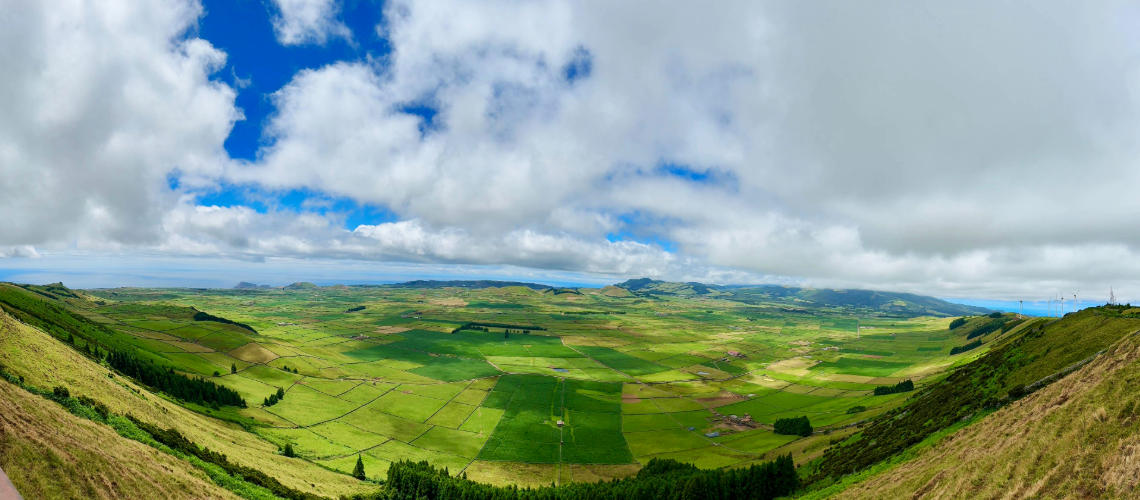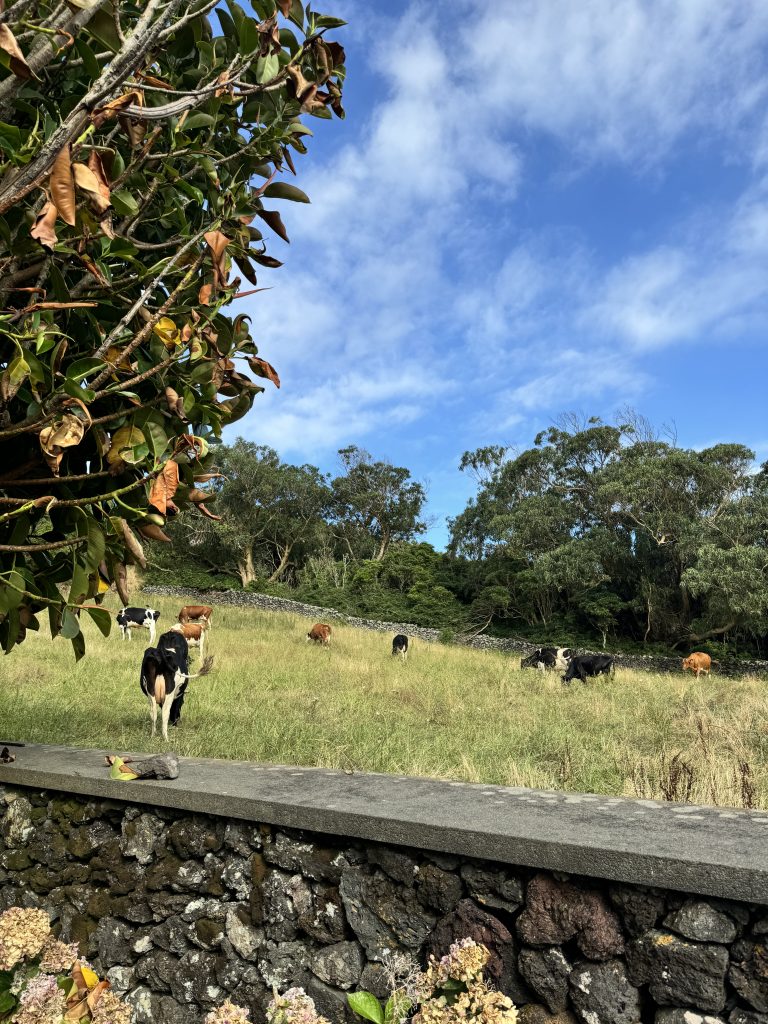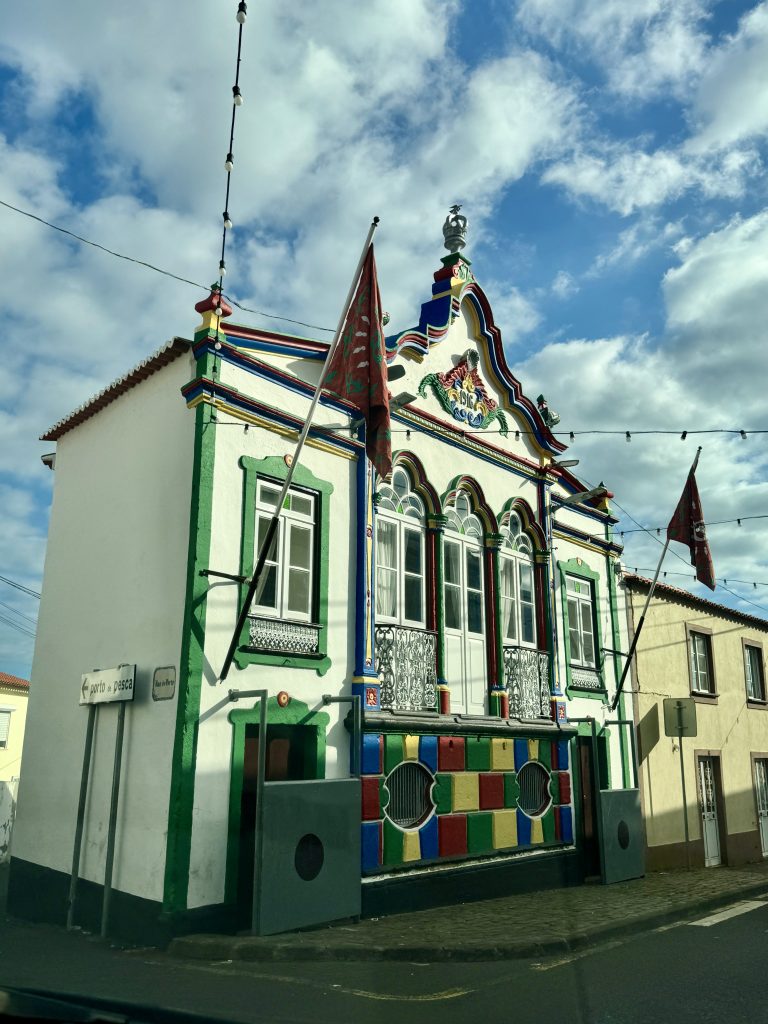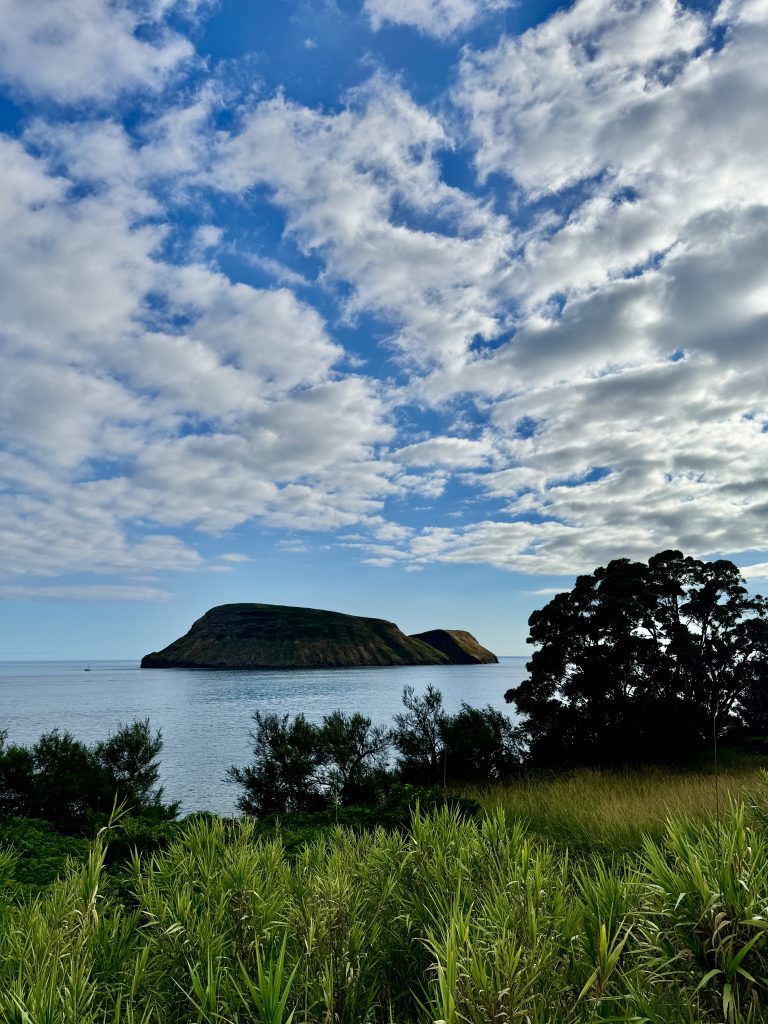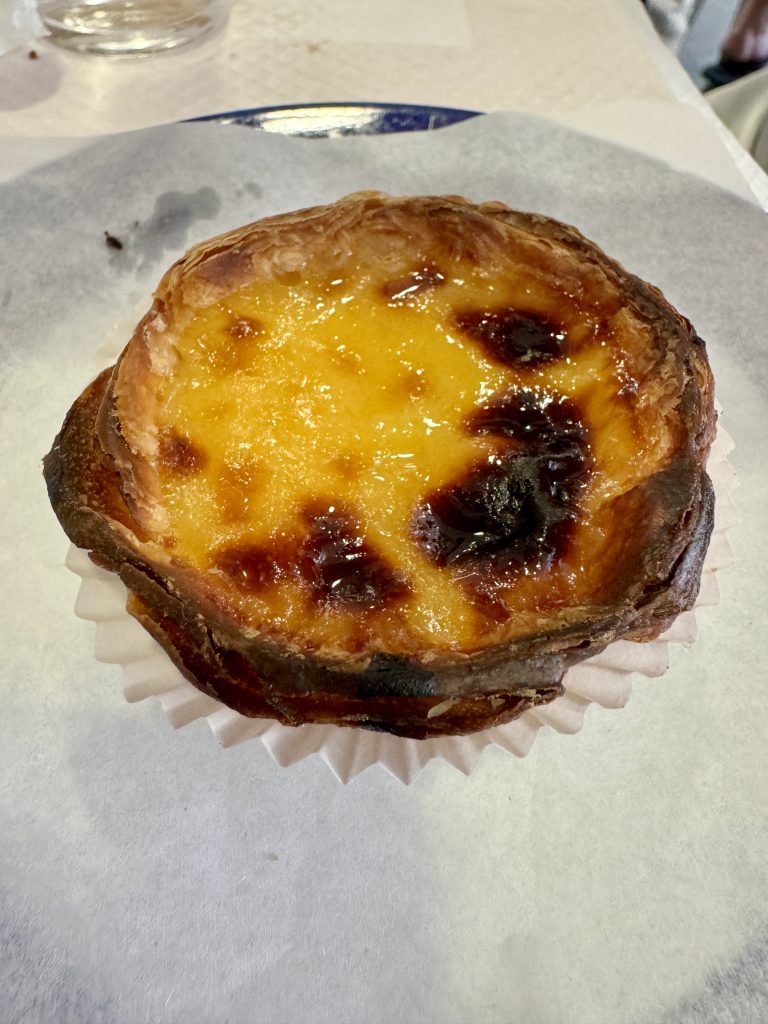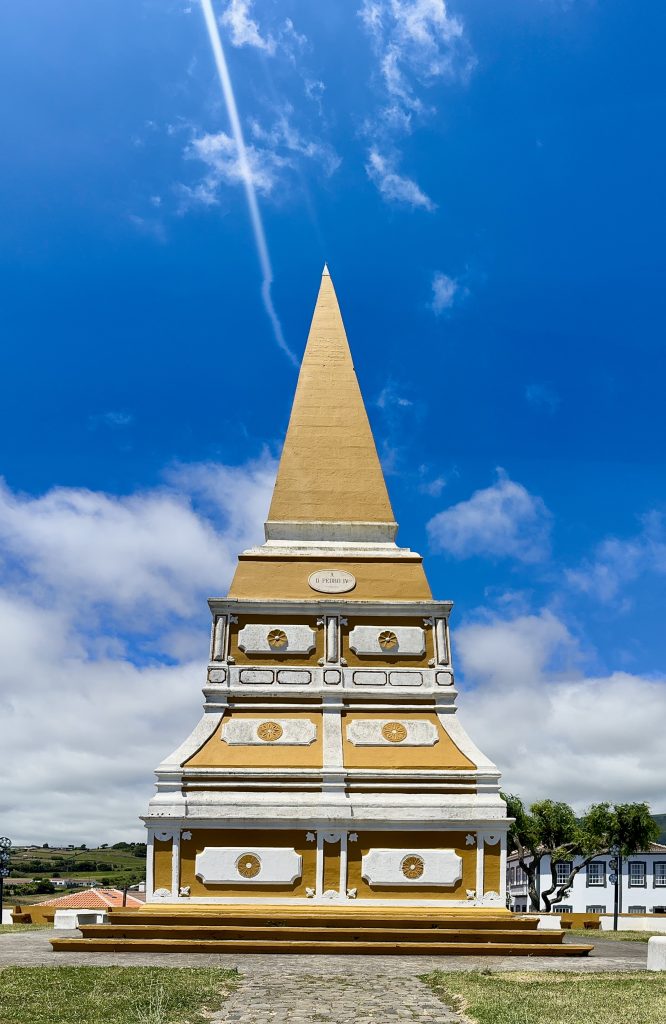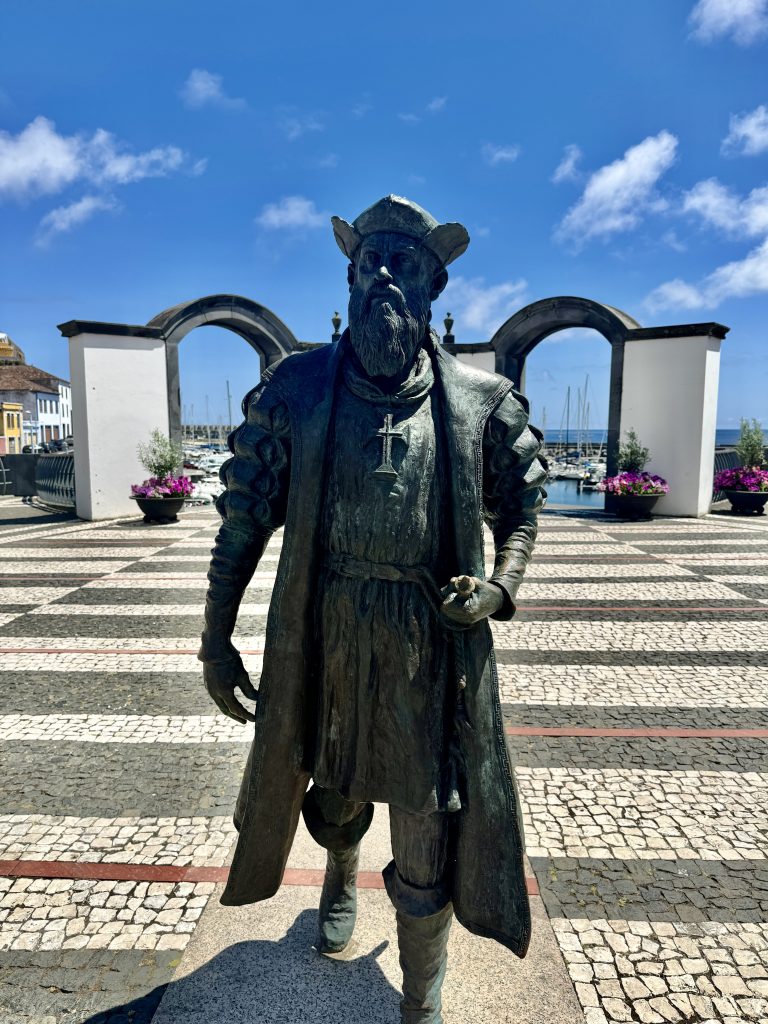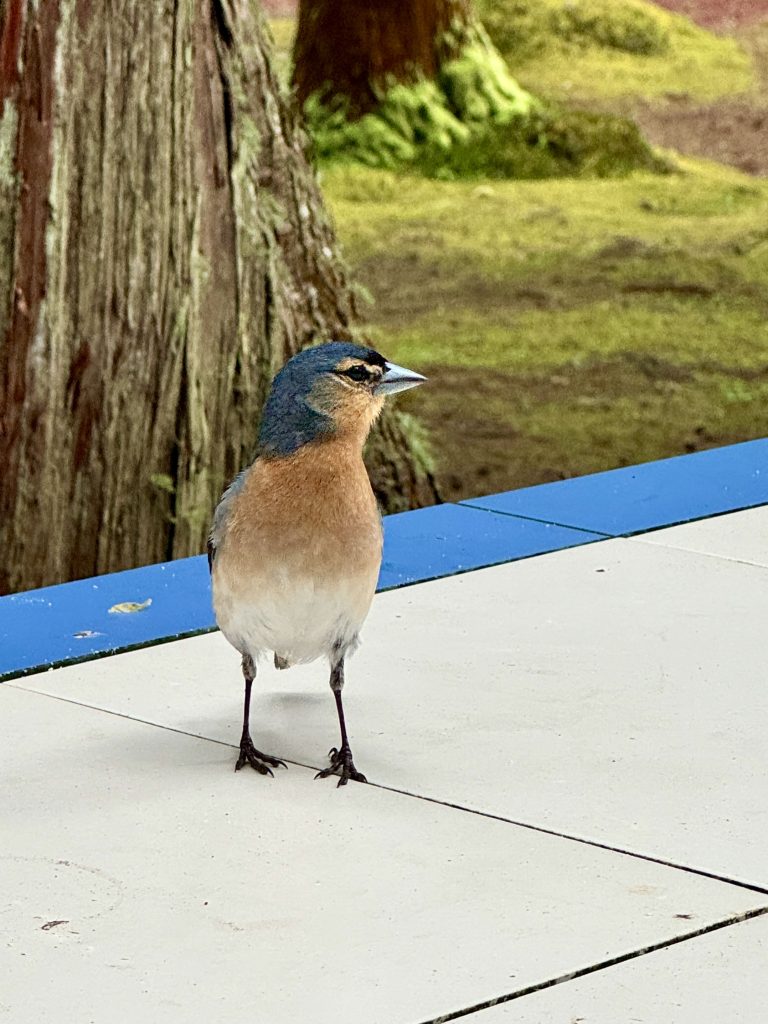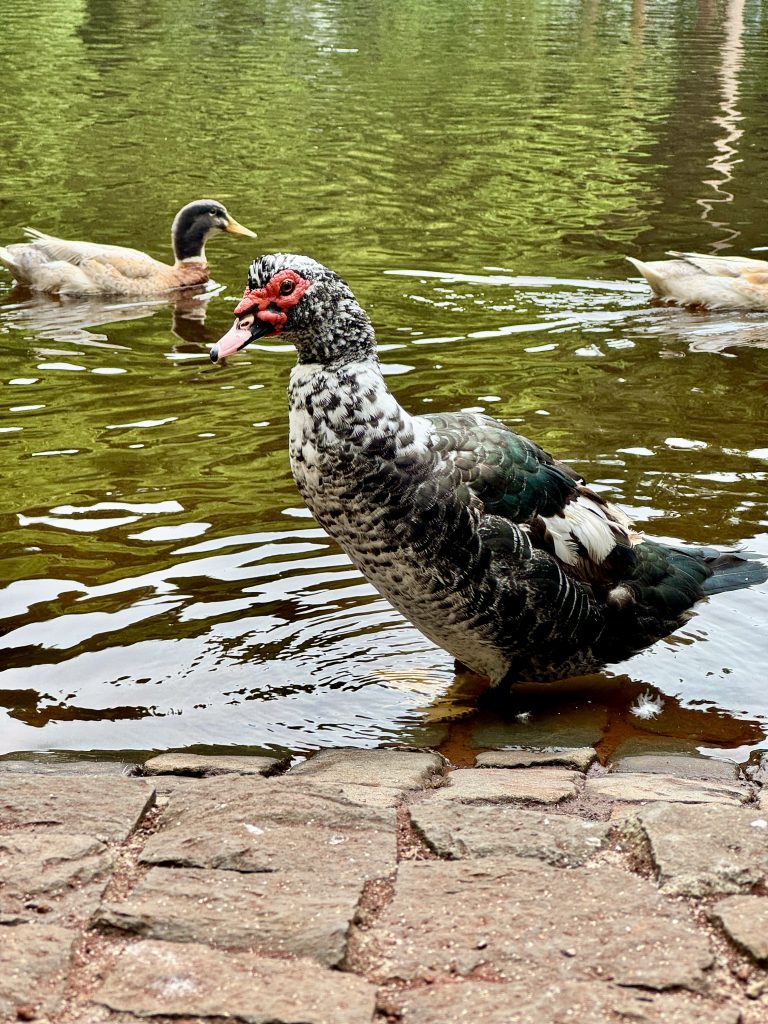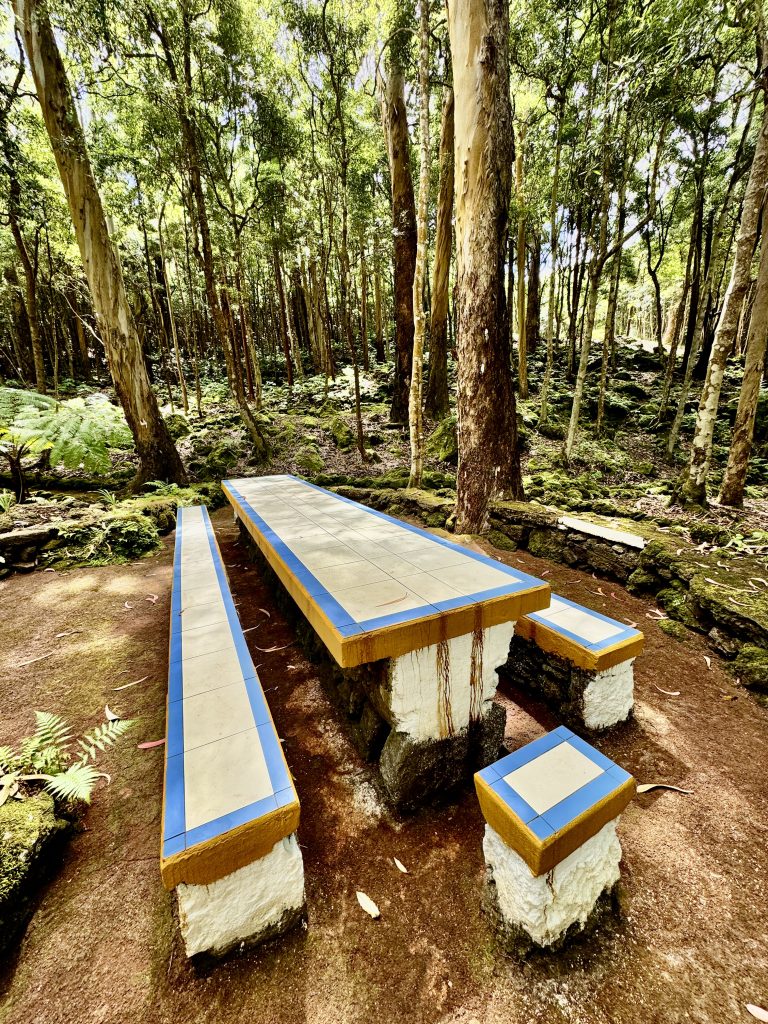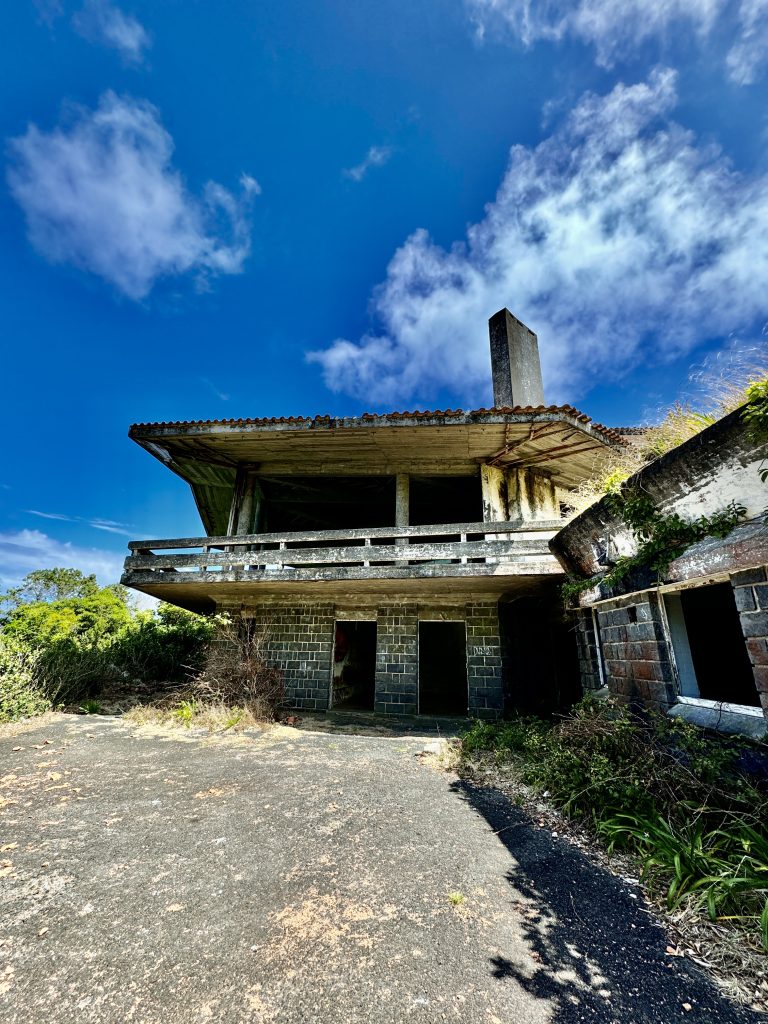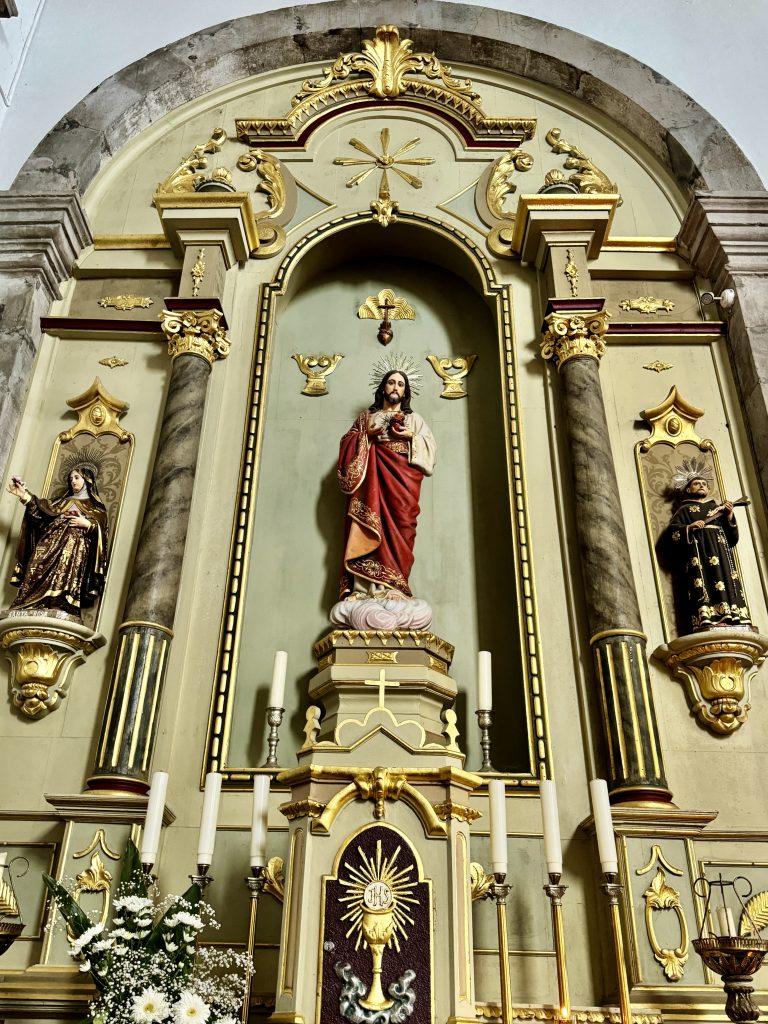Table of Contents
Where and what are the Azores?
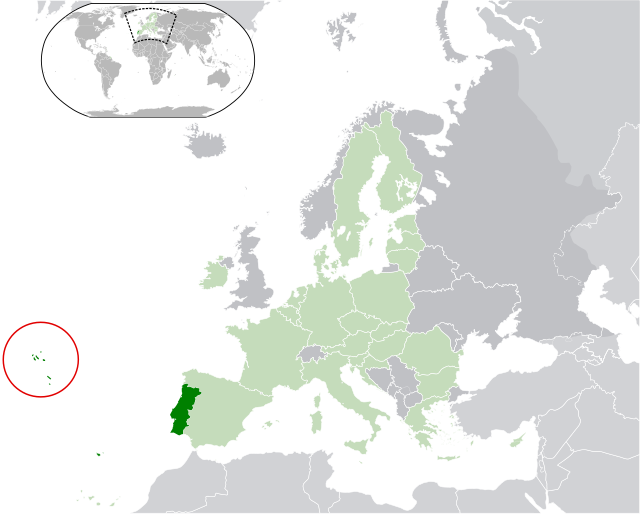
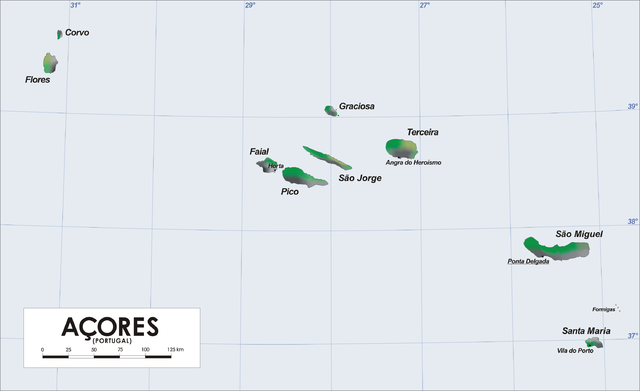
The Azores, a captivating archipelago in the middle of the Atlantic Ocean, is gaining popularity as a must-see destination for travelers seeking a unique blend of natural beauty and charm reminiscent of Hawaii. Comprising of 9 islands located around 2,460 miles east of New York, this volcanic paradise offers a diverse landscape of craters, lava tubes, volcanic beaches, laurel forests, and both active and inactive volcanoes, creating a haven for nature enthusiasts.
Each island in the Azores boasts its own distinct allure, culture, and natural wonders, making every visit a truly individual experience. Our receptionist, Frey, had the opportunity to explore two remarkable islands – Terceira and Pico.
Terceira, fondly known as “The Lilac Island,” is the third largest island in the archipelago. It is adorned with striking blue and purple hydrangeas that line the winding roads, adding a touch of enchantment to the island’s landscape.
Pico, on the other hand, is referred to as “The Gray Island” and “The Mountain Island,” owing to the colossal mountain that dominates its skyline. Visitors to Pico can indulge in three iconic activities: scaling the impressive mountain, savoring the renowned Pico wine, and embarking on thrilling whale watching excursions.
For Frey, the trip to the Azores held a special significance as her family traces its roots back to these islands. It was a dream come true for her to reconnect with her ancestral homeland, immerse in the local culture, and uncover the rich history that shaped her family’s narrative. The Azores left an indelible mark on her heart, blending natural wonders with cherished familial ties in a truly unforgettable travel experience.
A Smooth Journey from Portland, Oregon to Terceira, Azores

Living in Portland, Oregon makes the journey a bit complicated, though, since there are no non-stop flights it’s always at least a 2-stop flight. My trip began the day of the global CrowdStrike outage which luckily did not affect me because I flew Alaska Airlines to JFK. My flight to JFK was about a 5-hour ordeal, but it went by relatively fast all thanks to my trusty Kindle and a few casual naps. I landed in New York at 11PM EST and I had a 12-hour layover, so I booked myself a room at the Marriott Residence Inn JFK for the evening to shower and rest before the last 5-hour leg on SATA Airlines to the island of Terceira.

When I bought my tickets from SATA Airlines website a few months prior, they gave me an option to pay $45.00 for access to the Air France lounge which I gladly did! The lounge provided a serene pre-flight oasis, complete with delicious food and premium water which I filled my water bottle with — a must for this self-proclaimed water snob. I also splurged on 50€ on an extra seat for more comfort and space to spread out which was awesome! I mean if you’re going to be traveling to another country, you might as well go in style, right?
While we were in the air, I saw the top of Pico Mountain peeking through the clouds which got me all excited for my upcoming climb. After landing on Terceira Island, a shuttle took us to the customs portion of the airport which was, luckily, a breeze. The house I was staying at in the town of Santa Bárbara belongs to our family and is a 45-minute drive from the airport. Since I arrived close to 9PM, all my adventures would have to wait until the next day.


A Taste of Portuguese Life in Santa Bárbara

The Azores’ time zone is 7 hours ahead of Pacific Standard Time so you can only imagine the jet lag I felt waking up the next morning, but I had to quickly pull myself together for lunch with some family friends. We snagged lunch reservations at Por Do Sol, a cozy Portuguese restaurant down the street from our place, around 12:30PM. The restaurant had a buffet-style setup with an array of seafood choices and pasta salads. While it was a decent spot, it was one of the only dining options in Santa Bárbara aside from the Snack Bar down the street.
Post-lunch, we ventured to the Parque de Lazer – Pezinho de Nossa Senhora and the Miradouro de Santa Bárbara. The sight of the ocean waves crashing against the island’s rocks was simply breathtaking, offering picturesque views of São Miguel and a peek at Pico Island behind it. Spending about an hour exploring the area, we stumbled upon a surprising discovery – a bullfighting ring. The heat here took me by surprise; the sun and humidity make sunscreen a must-have.
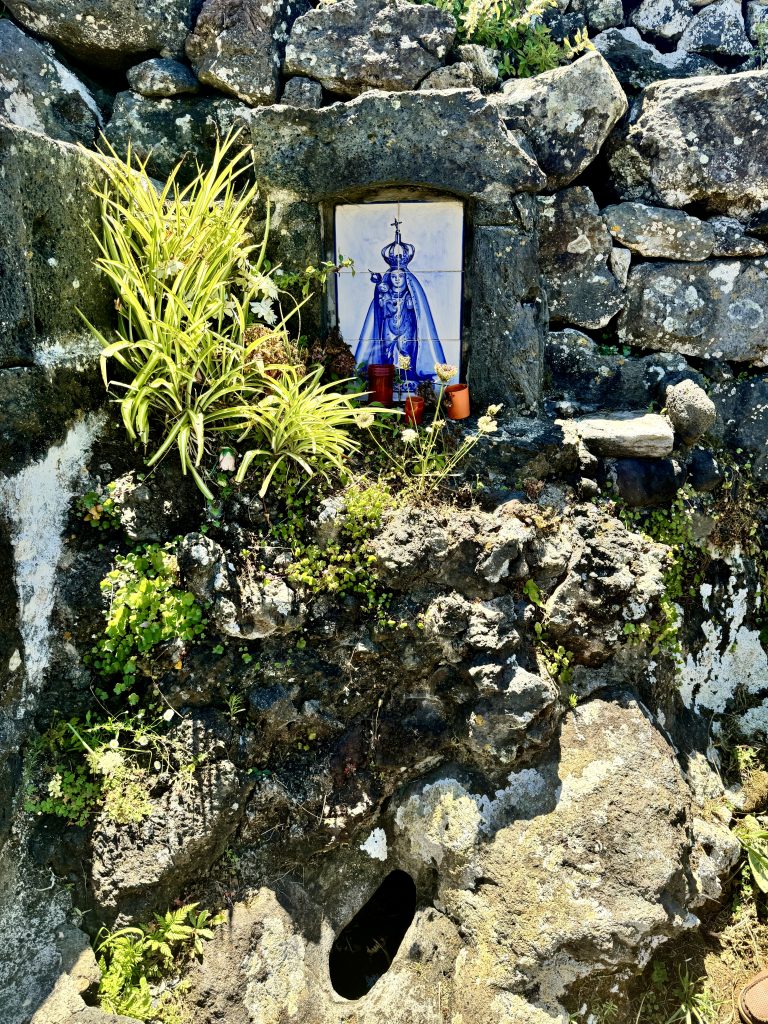

The hole in the ground is shaped like a foot, hence the name. It’s been around since even before my grandma was born. She said she and the townspeople would come here to acquire the water that would accumulate in the hole of the foot because it was blessed and would heal people.

Later, I ventured on a solitary evening stroll for about an hour, and I never once felt unsafe to walk by myself. Though the lack of sidewalks, coupled with blind spots on the roads and reckless drivers, added a layer of caution. My tip would be to hug the sides of the road, staying visible in blind spots to ensure a safe walk.
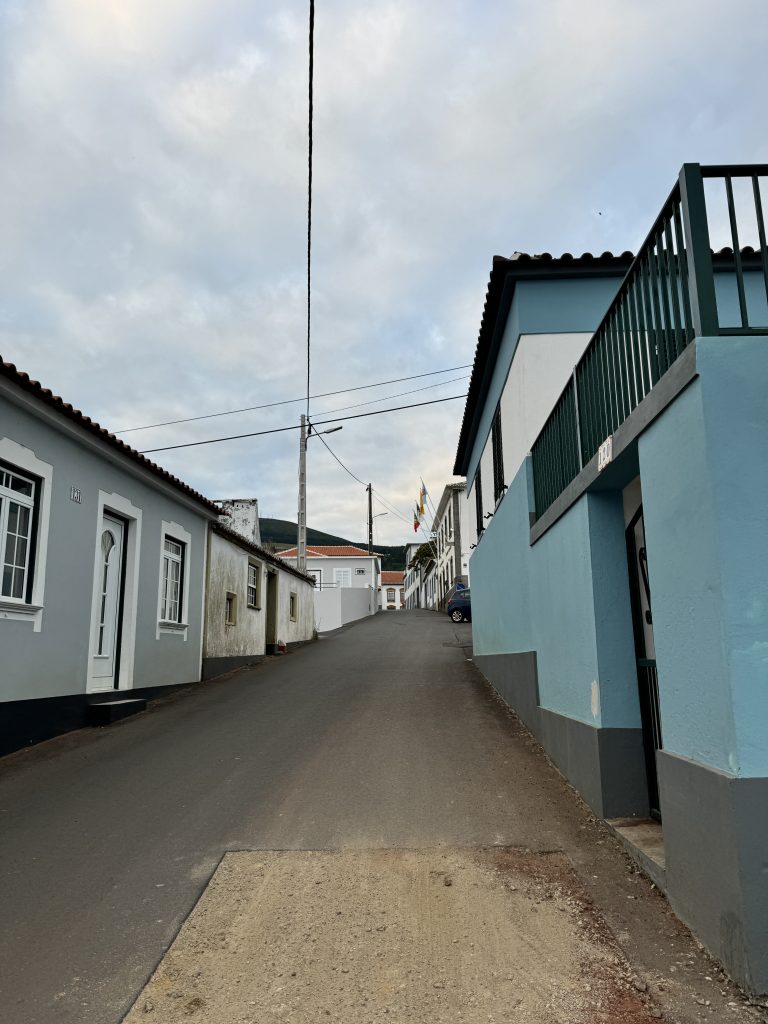

Right: This cute church was just a minute walk down our street.
Island Hopping from Terceira to Pico

My grandmother arranged for a family friend to drive me to Lajes Airport in Terceira around 11AM for my flight to Pico Island. The scenic drive offered glimpses of the stunning coast and the charm of Angra, the closest city, sparking anticipation for exploring it later in the week. Passing through the freguesias (towns), a kaleidoscope of colorful houses whizzed by, adding to the picturesque journey.
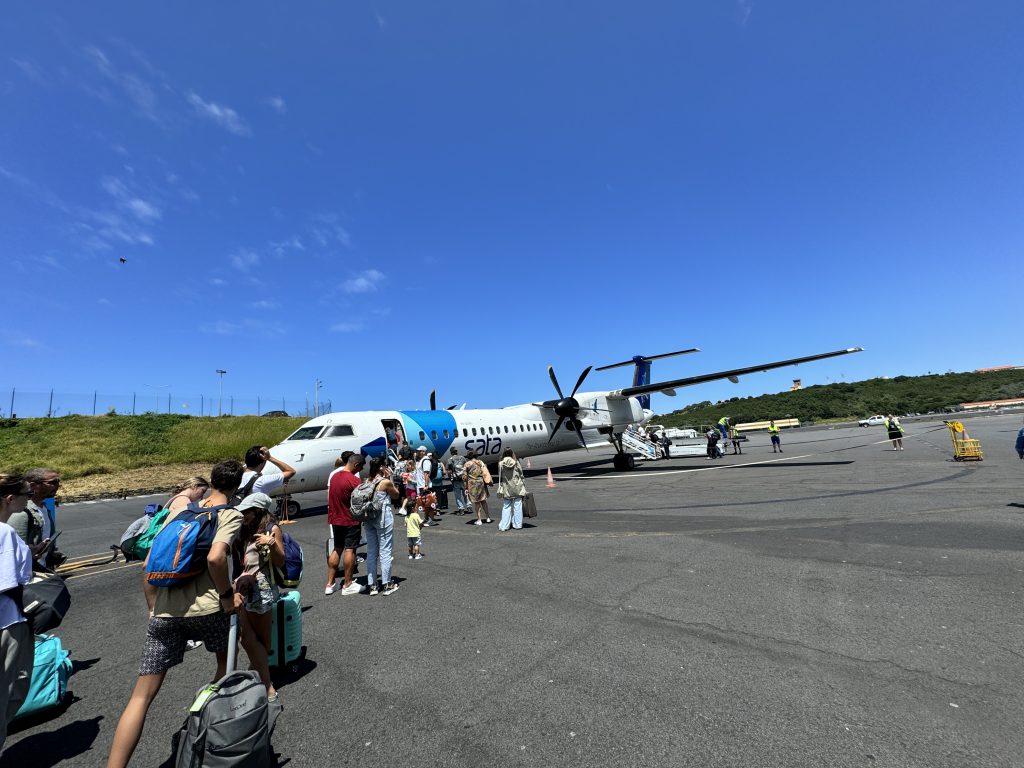
Flying between the islands necessitated smaller aircraft due to shorter runways, making the quick 35-minute flight to Pico Airport a delightful experience. Flying along the north coast of the island offered breathtaking views, with Pico Mountain shrouded in clouds. After a prompt baggage retrieval, I met my second cousin, Rui, for the first time, who kindly drove me to Madalena to check into Loving Strangers Hostel.


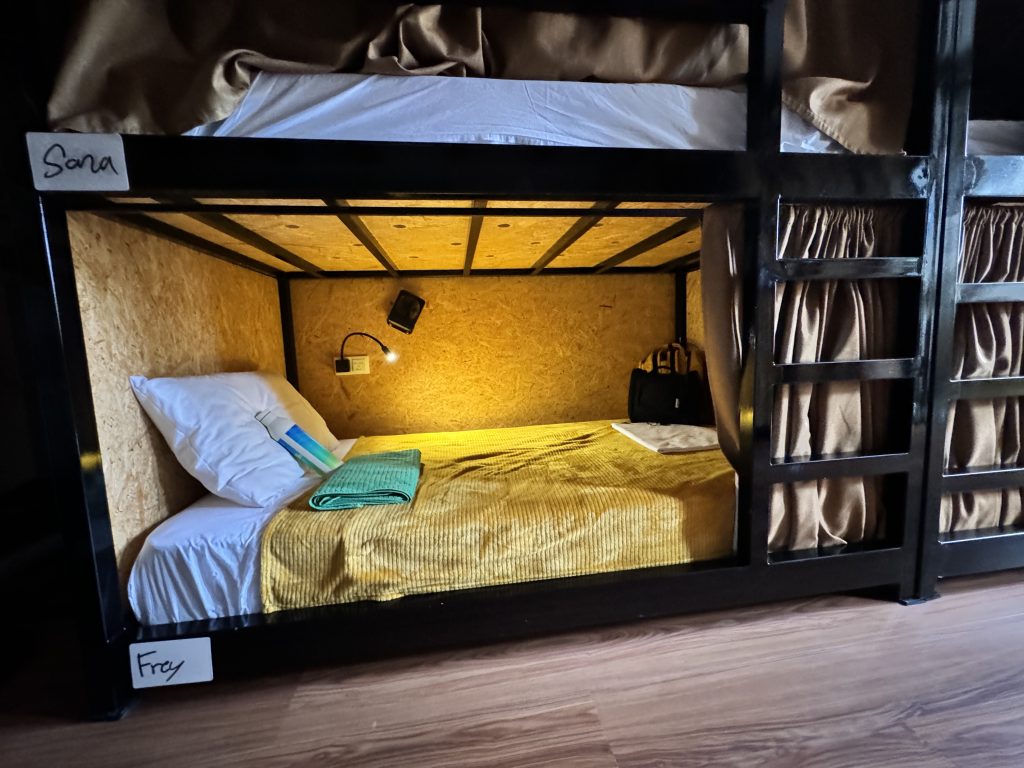
A girl named Astrid warmly welcomed me at the hostel, providing a towel and a tour of the charming property. The spacious bunks, equipped with blackout curtains, outlets, and fans, offered a cozy stay. The communal areas, including hammocks, garden spots, and a long outdoor table, fostered a welcoming atmosphere to mingle with fellow travelers. Two men, Stefan and Pedro, run the hostel and they will instantly treat you like family. Stefan makes breakfast for everyone every day and they have family dinners for 20€ each. As a solo female traveler, I never once worried about the safety of me or my property.

Exploring the island with Rui, we visited multiple miradouros (viewpoints) soaking in the mesmerizing ocean views and volcanic landscapes. In Piedade, my dad’s birthplace, I discovered the legacy of my paternal grandfather, who was a local blacksmith with a thriving wine business. He would ship the wine and moonshine he made all over the islands! So cool! Returning to the hostel, I rested for the next day’s climb at the Mountain House, setting the stage for my exciting adventure on Pico Island.
Conquering the Climb to Pico Mountain
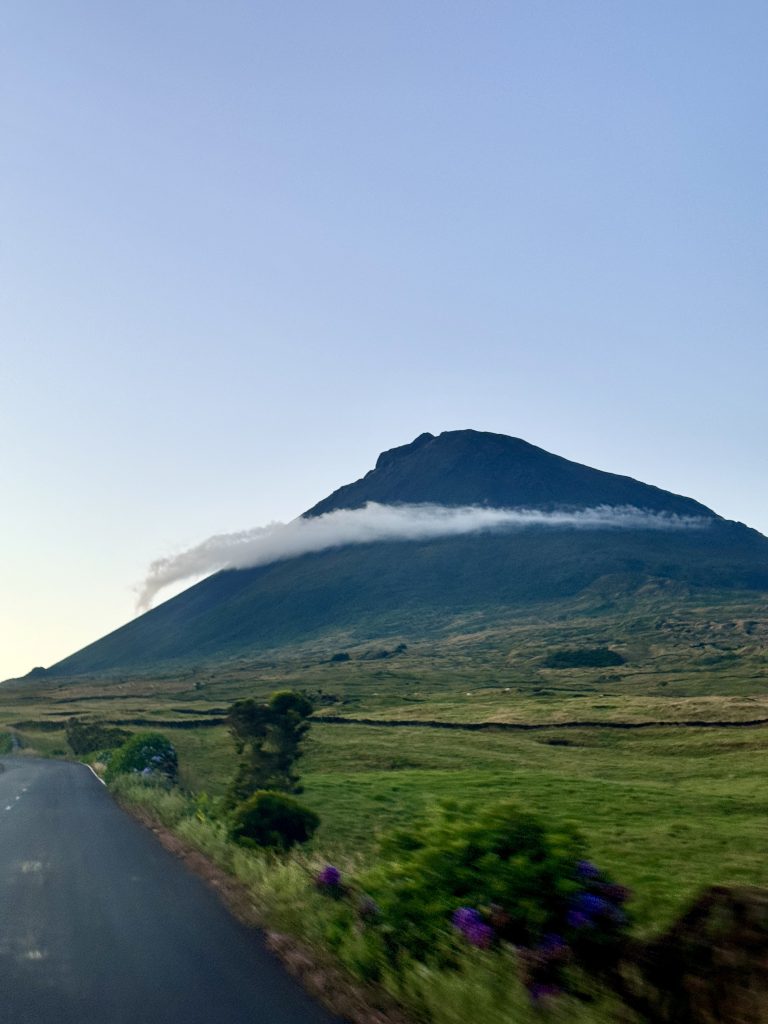
I woke up at 5AM, buzzing with excitement and a bit of nerves, ready to conquer the tallest peak in Portugal. As I packed everything I needed for the 8-9 hour climb, I realized I had forgotten to grab essential supplies like water, snacks, and sunscreen while exploring the island with my cousin the previous day.
Thankfully, Pedro came to the rescue with a giant bottle of water and some sunscreen. I already had a couple of protein bars and energy gummies in my pack, and after rummaging through the hostel’s kitchen, found some fruit to take along. My backpack, equipped with a 22L water bladder filled to the brim, plus an extra bottle of water, made sure I was well-prepared.
Dressing in layers was crucial for the unpredictable mountain weather. I layered up with a long sleeve shirt, a breathable sweater, a lightweight Columbia jacket, heavy-duty Keen hiking boots, and water-resistant cargo pants. I had a hat too, but the wind kept blowing it off, making me regret not having a hat with a drawstring.
I met my guide, Sonya, in front of Pico Island Adventures at 6:20AM, and we arrived at the Mountain House by 6:45AM. This essential pit stop requires everyone climbing Pico to pay a 25€ fee and receive a GPS tracking device. Since we were with a guide, the fee was included in our tour price, and Sonya was responsible for the GPS.
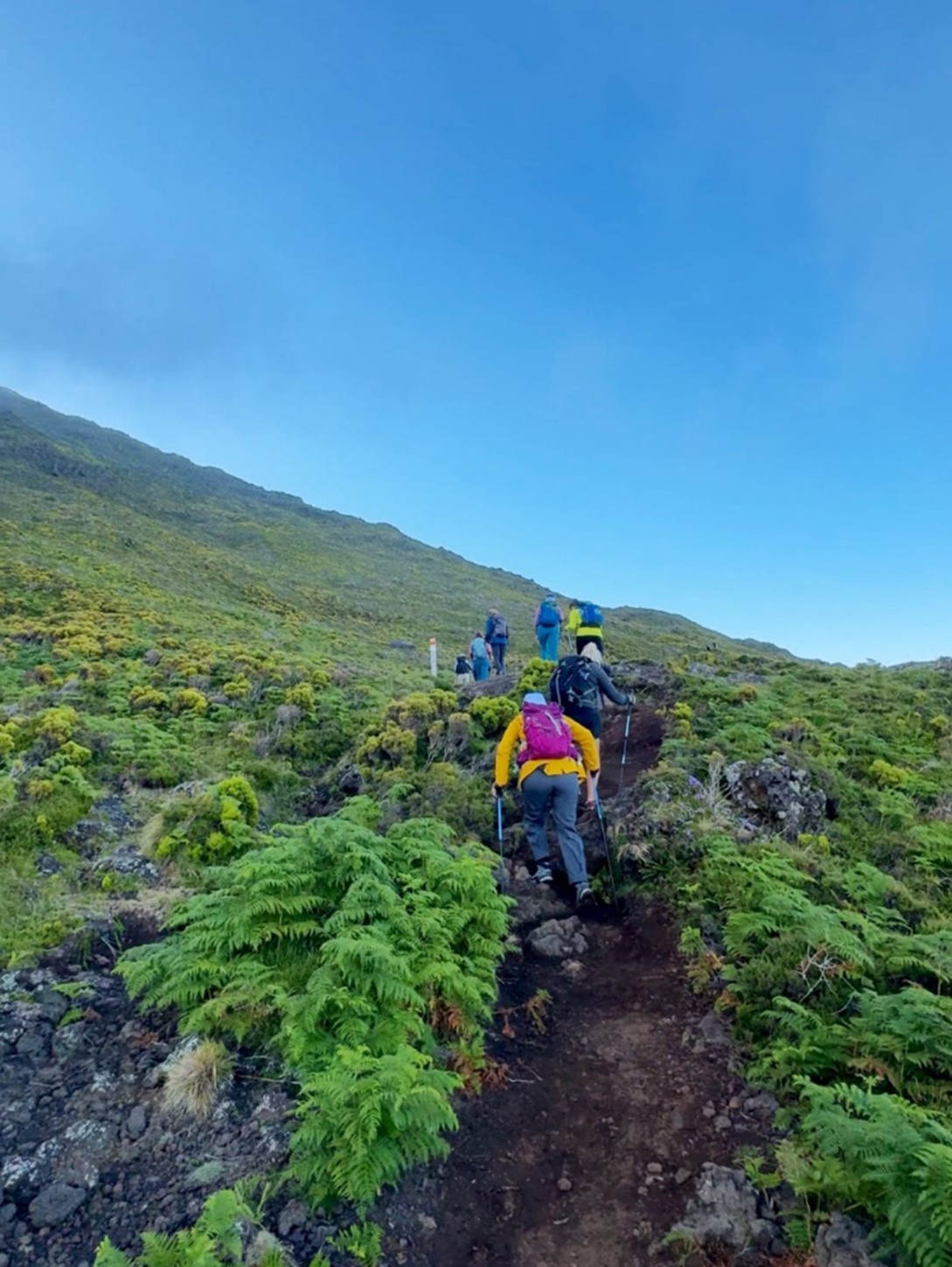
The base of the mountain featured mostly dirt and uneven volcanic rock with occasional patches of grass. As we neared the caldera, the terrain became rockier, requiring more intentional steps. Sometimes I had to grip both trekking poles with one hand and use the other hand to pull myself up. The trail was marked with red and yellow lines on boulders and numbered wooden poles from 1 to 47. By marker 44, we were virtually at the caldera.

Standing inside the 1,600ft circumference of the caldera was surreal; its size distorting the height perception of Piquinho, the final, vertical climb. I took a zoomed-in video trying to show how other climbers looked like ants on the tiny mountain! Some group members stayed behind as the last 70m climb required ditching trekking poles. Tapping into my old indoor rock-climbing skills, I carefully ascended, focusing on foot placement and correctly gripping the rock.
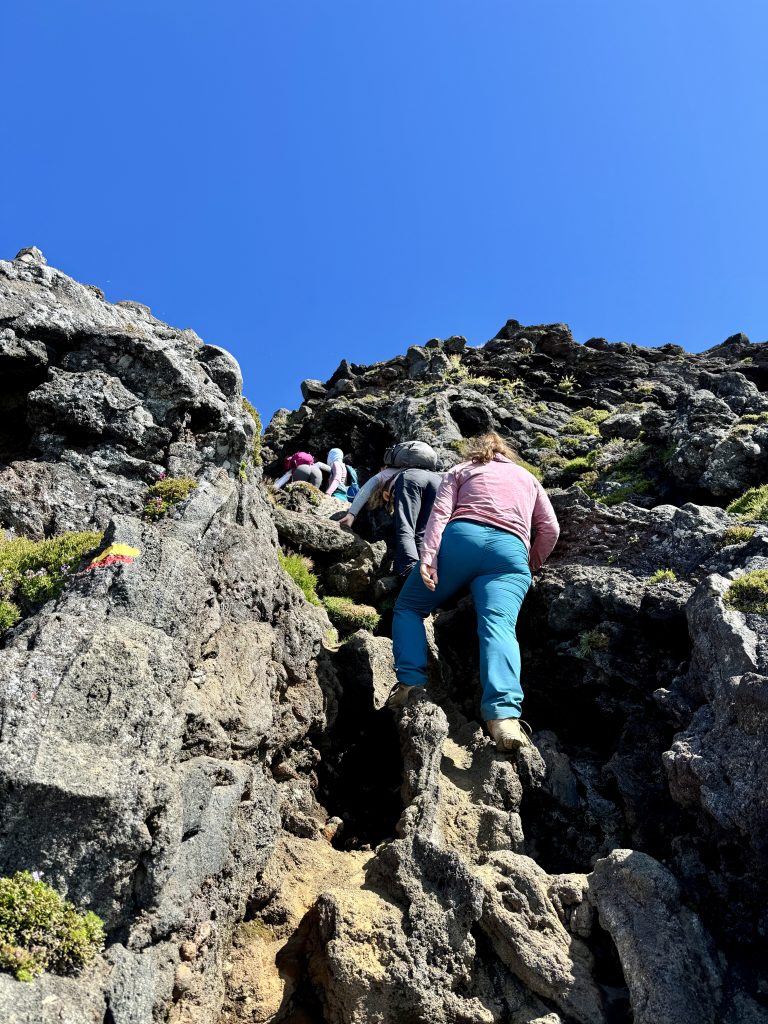
Reaching the peak, I was awestruck by the breathtaking views and thanked the cloud gods for clear skies. We could see the point of Pico Island and four other islands: Terceira, São Miguel, Graciosa, and Faial. The sense of accomplishment was extraordinary, viewing my family’s homeland from that height is unforgettable. Descending was exceptionally tougher, using the trekking poles to prevent falls. My tired knees often buckled, forcing me to crouch and slide on the rocks, prioritizing safety over pristine pants.

I’d caution against this climb for people with intense fear of heights or significant physical limitations. That said, there were two women afraid of heights who made it, and an older woman with vertigo and a man with a knee brace who reached the caldera but couldn’t climb to the peak. Climbing Pico is definitely a challenge, but everyone’s limits are different – climb at your own risk and enjoy the breathtaking scenery the whole way.

Adventures in Praia da Vitória
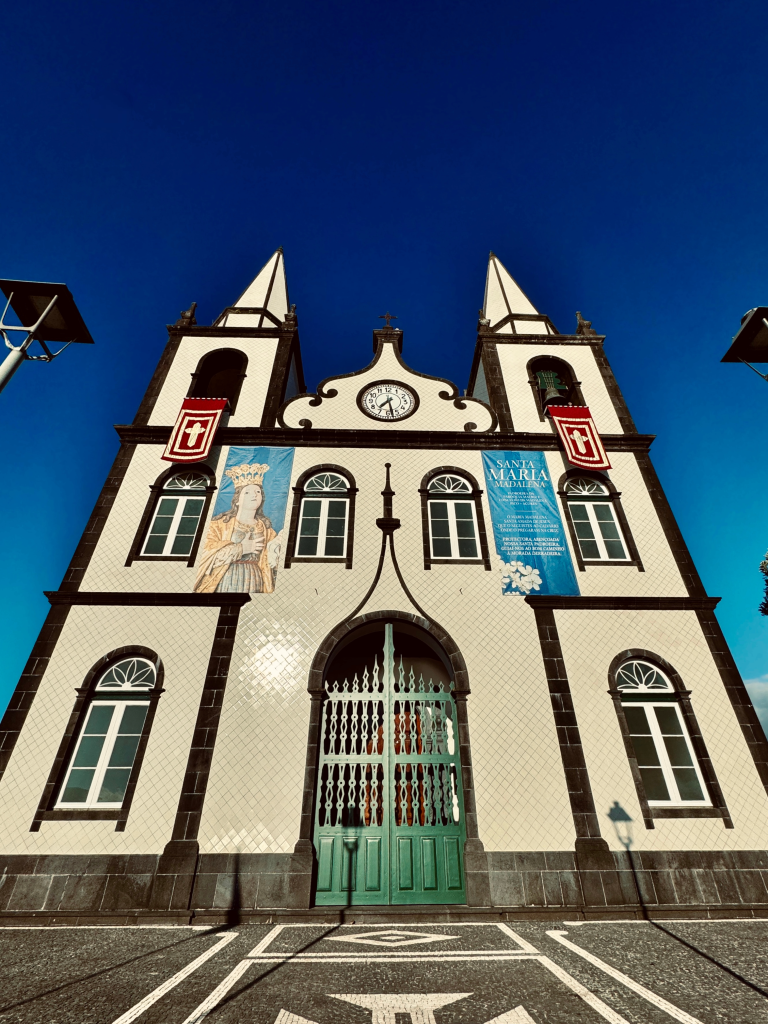
Waking up today was brutally hard, not just because of being sore from an epic 8.5-hour mountain climb but also from the awful sunburn on my head, ears, and neck. It felt like I had a fever, and my head was pounding. All I longed for was to sleep the entire day, but it was already 10AM. I had to get ready, pack, and explore a bit of Madalena before my flight back to Terceira that afternoon.
I grabbed an energizing cafezinho at a cozy spot called Simpatia before heading to Adega das Artes, a charming gift shop, to pick up some souvenirs. After returning to the hostel, I said my heartfelt goodbyes to Pedro and some of my roommates. Stefan then kindly drove me to the airport in his convertible while we bumped ‘90s club music and danced the whole way. The Loving Strangers hostel earned 10/10 in my book; it’s ideal for anyone, whether you’re on a budget, traveling solo, as a couple, or with friends. I absolutely plan to return to Pico and stay with them again in the future!
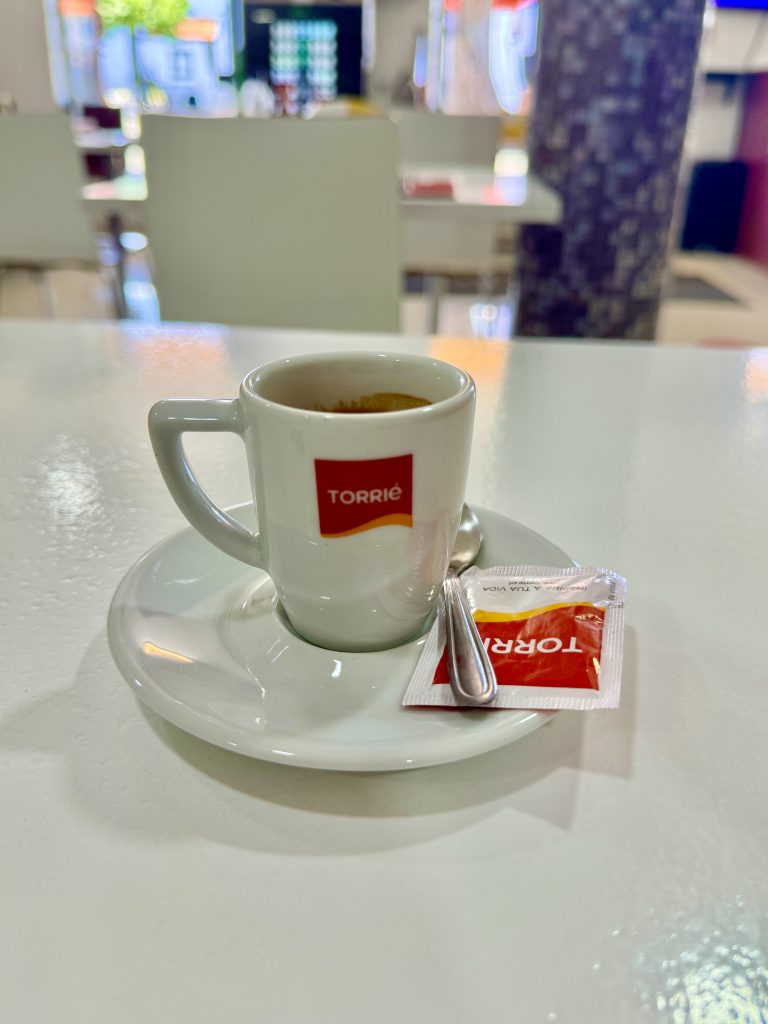
My flight back to Terceira was as smooth and swift as the journey there. My godmother, Raquel, picked me up for an all-day sightseeing adventure around Praia da Vitória. We kicked things off by visiting the Facho Viewpoint near the joint American and Portuguese air force base where she lives. Praia da Vitória boasts the island’s only sandy beach—every other swimming spot is made of volcanic rock and concrete. It’s one of Terceira’s significant cities, brimming with miradouros, restaurants, and shops.
A particularly notable site was Ermida de Maria Vieira, a shrine dedicated to a 13-year-old girl who became a saint after tragically being attacked in 1940. The locals hold this ground as sacred, reflecting the deep-rooted religious tradition of the older Azorean population.
For dinner, we went to Quinta dos Açores, a massive restaurant reminiscent of the Tillamook Creamery in Tillamook, Oregon. It takes pride in serving ingredients from local farmers, ensuring everything is fresh and delicious. While the menu leans heavily toward meat, it also offers some vegetarian options. Their house-made ice cream is a must-try! On the way out, I couldn’t resist picking up a bottle of local vinho verde from their market, perfect for the week ahead.
Exploring Monte Brasil, Angra do Heroísmo and Lagoa das Patas
My grandparents arranged for our dependable driver to take us to Monte Brasil, the remnants of a volcano in Angra. The only access road passes through the impressive car gate of the Fortress of São João Baptista, built around 1567 and still occupied by the Portuguese Army. The mountain is surrounded by various fortresses, serving as historical guardians of the island. Our first stop was Miradouro do Pico das Cruzinhas, offering panoramic views of Angra, with anti-aircraft artillery and bunkers from World War II.



The primary reason I wanted to visit Monte Brasil was to see the cat colony, run by dedicated volunteers who care for, feed, and sterilize the cats. While I didn’t see as many cats as I had hoped, I did get to pet a few adorable felines. My grandmother, a fellow cat lover, was delighted. If I had more time, I would have packed a lunch to enjoy on the picnic tables in this serene space where various animals coexist harmoniously.

On our way out of Monte Brasil, we admired the lush caldera with the Atlantic Ocean glistening in the distance. We then headed to Jardim Duque da Terceira, a multi-storied garden in Angra, free to the public from 8AM to 10PM (depending on the month). The garden features benches, walking trails, fountains, and flowers. My grandmother bought popcorn at a nearby bodega to feed the numerous pigeons, and it was touching to see her and my grandfather so joyful. After feeding the pigeons, I walked up to the monument of Dom Pedro IV for a spectacular view of the city of Angra and Monte Brasil.
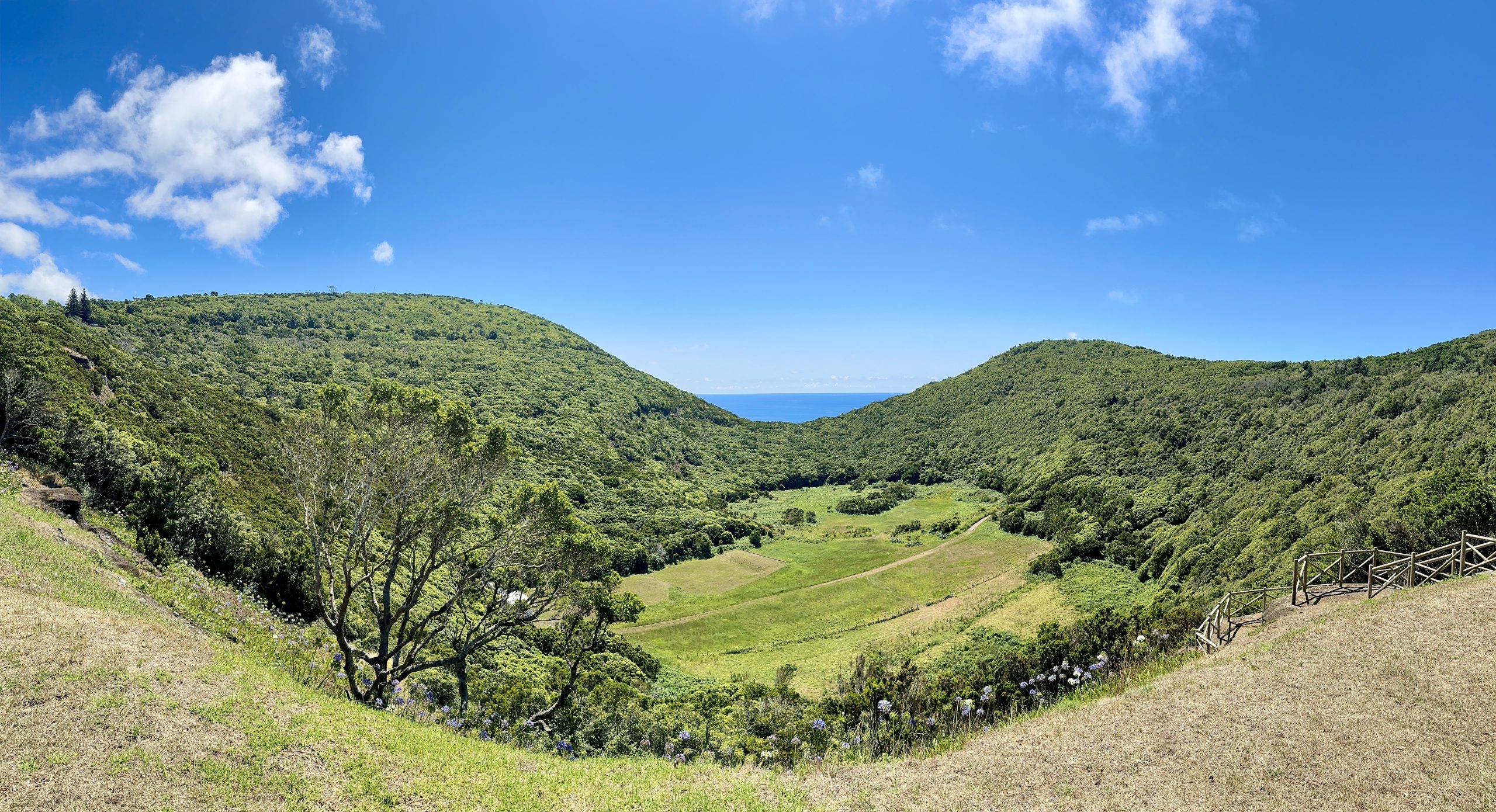
We had lunch at Snack Bar Copacabana, renowned for its bakery. I highly recommend their queijadas de nata (Portuguese custard tarts) – the perfect balance of sweet, rich, and crunchy. Afterward, we stopped by the Marina of Angra to meet some family before heading to Lagoa das Patas. This protected natural reserve is filled with numerous hiking trails and picnic spots, reminding me of the forests back in Oregon. If I had more time, I would have loved to hike the trails and explore the area further.
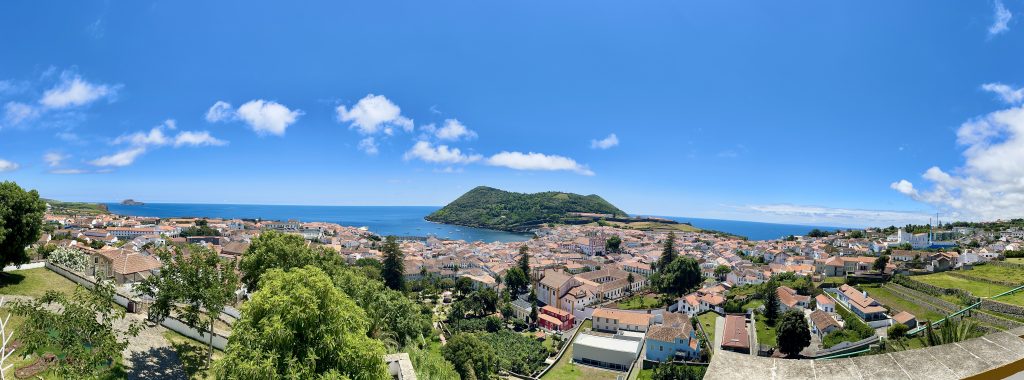
Discovering Familial Roots and Biscoitos
My grandmother and I woke up around 10AM to join my second cousin, Maria Lourdes, for a trip to Mata da Serreta, a recreational forest reserve in the town of Serreta. On our way there, we stopped by the house where my grandmother and her siblings were born. It was fascinating to hear her recall her life and point out the room where all the children were born.

Mata da Serreta is a beautifully forested area with wood-fired ovens, outdoor grills, and picnic tables. It also features a challenging 4.2-mile hiking trail to a small lake (lagoinha) on Santa Barbara Mountain. There is also an abandoned hotel built in 1969 by architect João Correia Rebelo who introduced the Modern Movement to Portugal. The hotel, which once hosted a summit in 1971 for notable leaders like Georges Pompidou of France, Marcelo Caetano of Portugal, and Richard Nixon, is now accessible to the public for exploration.
Serreta, the smallest town on the island, has a snack bar and a church. While my grandmother opted to pray at the church, my cousin and I enjoyed a few beers at the snack bar—a choice I jokingly attribute to my love of casual relaxation over religious devotion. Despite my lack of religious fervor, I do appreciate the architectural beauty of churches, and the island has plenty to admire.
In the afternoon, our driver took us to Biscoitos, home to the island’s most famous swimming hole. These natural pools, formed from volcanic rock, are bustling with people in the summer. Nearby booths sell souvenirs and food, with a restaurant conveniently located nearby. I ventured onto a small bridge, where waves crashed dramatically on the rocks, and we dined at Por Do Sal, sampling delicious grilled lapas (limpets). They arrived sizzling on a hot plate, spiced with paprika paste, garlic, and butter—absolutely divine!

After our meal, we headed home, and my grandmother stopped to pick wild hydrangeas and Norfolk Island Pine. Inspired by the day’s adventures, I decided to explore the island on my own. I rented a car online for the following day, excited to uncover more of Terceira’s hidden treasures.
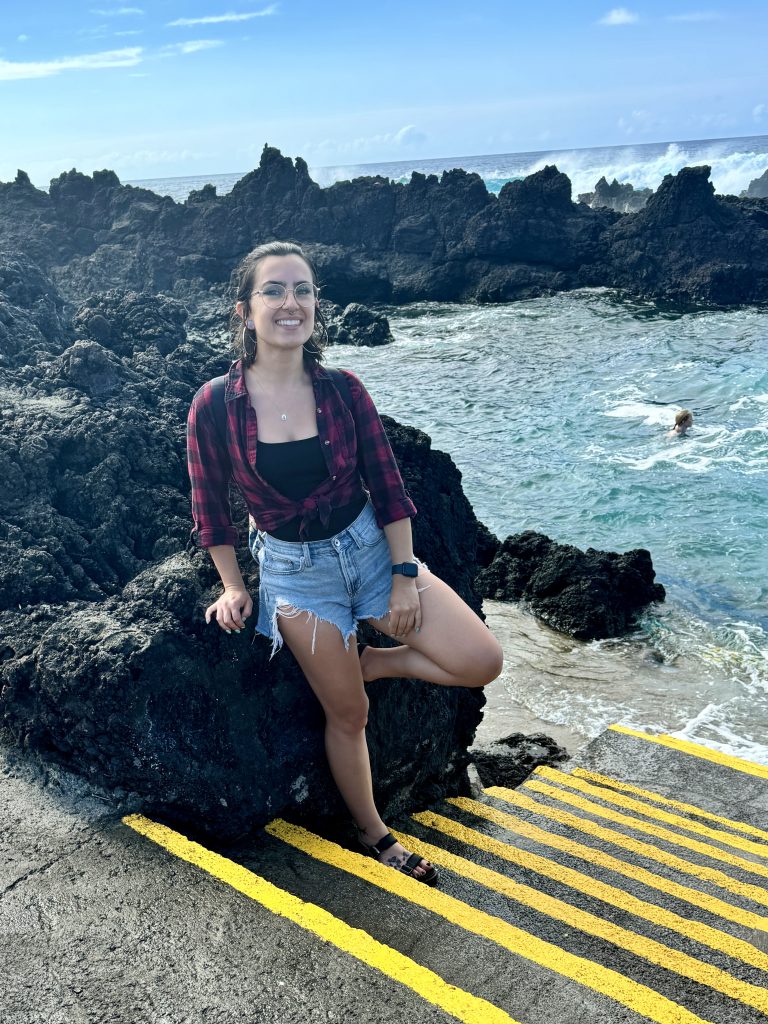


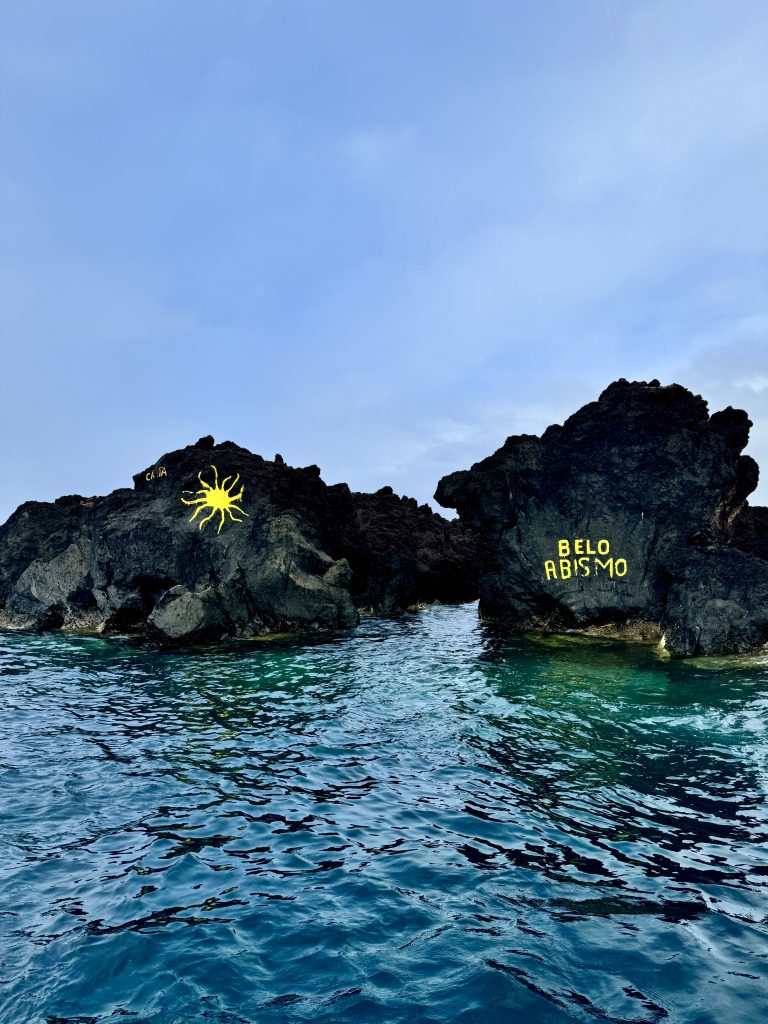
Cave Hunting and Volcanic Exploration
Today, I got an early start because public buses run infrequently on weekends. The bus stop near our house only operates five times on Saturdays. If I missed the 10:18AM bus, the next one wouldn’t arrive until 1:47PM, and my appointment with Way2Azores was at 12:30PM. To avoid any mishaps, I arrived early, though my grandmother assured me that buses often run late. When the bus arrived, I informed the driver that I was heading to Bailão and paid the 2€ fare. The seats were comfortable, and the air conditioning was a lifesaver.


After the half-hour ride to the city center, I had nearly two hours to kill before picking up my car. Famished and searching for breakfast, I discovered that most kitchens remained closed until noon or later. Eventually, I found John’s Cafe and ordered a baguette with “chicken paste,” which turned out to be 90% mayo. I forced myself to eat it and then ordered a giant cappuccino to wash away the taste. After breakfast, I picked up some souvenirs at Marina Souvenirs near the Cathedral of Angra before walking to Way2Azores. The rental process was smooth, and I confirmed my drop-off time for Monday at 3:30AM.


Given an Opel Crossland, a small SUV with left-side steering and driving on the right side of the road (just like back home in the States), I felt at ease. If you’re planning to drive on the island, ensure your car is automatic unless you’re comfortable with manual, and familiarize yourself with basic street signs.

Renting a car is the best way to explore Terceira, as public buses only travel the main island roads. My first stop was the Miradouro da Serra do Cume, offering sweeping vistas of Terceira’s farmlands and the Praia da Vitória. Descending was equally narrow but scenic, driving through little rectangles seen from above with cows grazing peacefully.

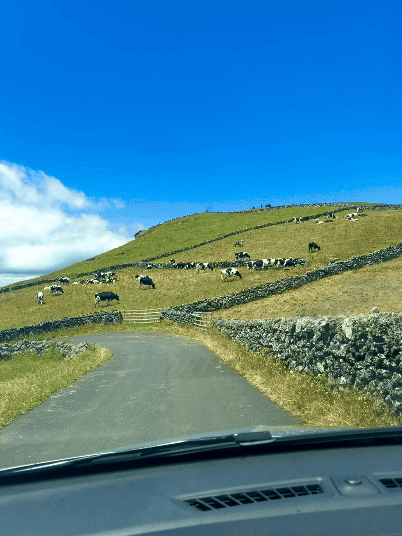
Next, I visited Algar do Carvão, a giant lava tube and popular tourist attraction. I purchased a single ticket but later learned that a combination ticket would have saved me 5€. The long tunnel led into the cave’s expansive mouth, with lush moss adorning the walls. A rocky staircase descended further, with water continuously dripping from above. The temperature was cool, and the walking surfaces wet, so caution was necessary. A lagoon at the cave’s deepest point and illuminated rock formations added to the spectacle. Exploring the cave and exhibit took around 30 minutes. Note that the visit isn’t suitable for those with physical disabilities due to the many stairs, and appropriate footwear is essential.


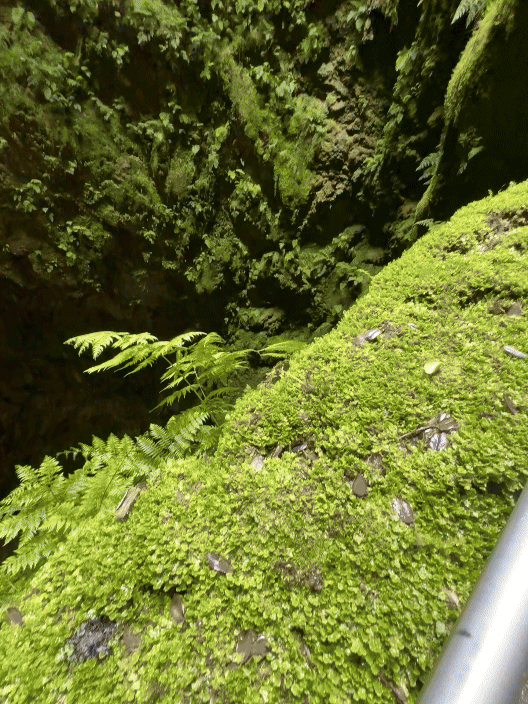
Following that, I headed to Furnas do Enxofre, where cracks in the earth emit steam and sulfuric gases. Rustic wooden pathways integrated the short hike around the vents and informative signs sprinkled throughout the walk to pique the curious mind. It felt like I was whisked away into a little Hobbit land!



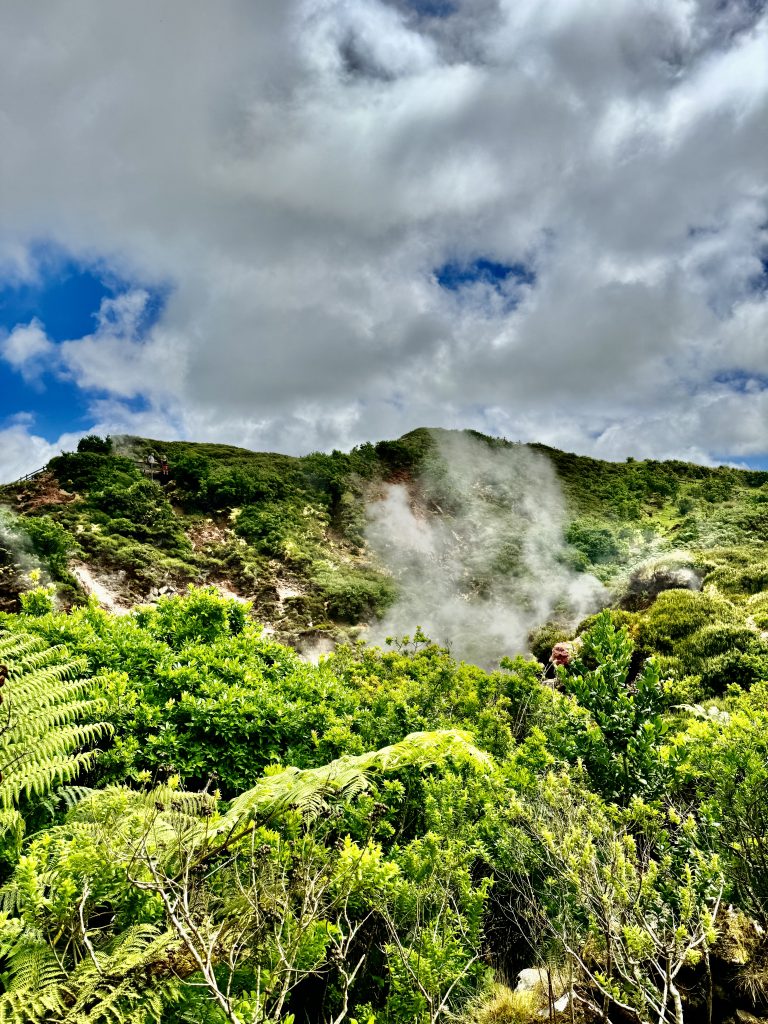
Next, I explored Gruta do Natal (Christmas Cave). The house above the cave features a photographic exhibit of historical activities like religious masses and baptisms. Opened to the public on December 25, 1969, the cave is a complex lava tube. Visitors receive hard hats to navigate low openings and avoid low-hanging stalactites. The uneven, jagged ground and some small spaces heightened my claustrophobia, so I rushed through, despite the fascinating formations.
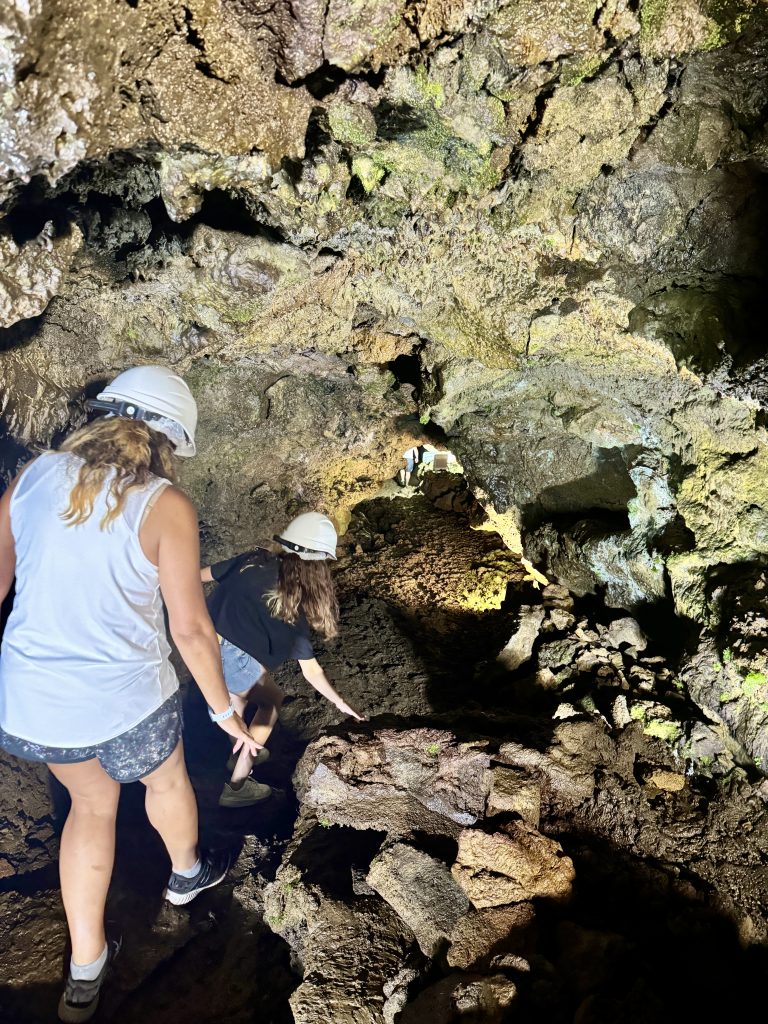
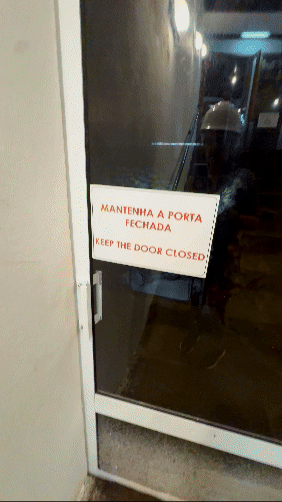
My final stop was the Miradouro da Serra de Santa Bárbara, the peak of Santa Bárbara Mountain. The winding, narrow road up was deserted in the late afternoon. Sadly, the view was obscured by fog upon arrival, but seeing the island’s weather forecast station was interesting. In the evening, we attended a local fundraising dinner for an upcoming festa (festival) at the end of August. The multi-course meal included bread and butter, pumpkin soup, seasoned pork chops, bacalhau à brás (salted cod with potatoes), carrot cake, and various Portuguese wines. It was heartwarming to meet the locals and enjoy the most authentic meal of my trip!

Ponta do Mistério & My Final Day on Terceira
This was my last full day on Terceira, so I headed back to Biscoitos in the afternoon to hunt for traditional Portuguese wooden clogs for my sister, but luck wasn’t on my side. Since I also needed to stop at the airport to resolve an issue with retrieving my e-ticket for the flight from Ponta Delgada to Boston, I decided to explore the northeast side of the island.
During my adventure, I stumbled upon a fantastic hiking trail called Ponta do Mistério, an approximately 2.5-mile trail I discovered on Google Maps. The trail was delightfully uncrowded—I only encountered four other people in the two hours I spent there—making it feel like a hidden treasure. Walking alongside cows grazing in picturesque pastures and through tree arches on the edge of a cliff, I enjoyed one of the most stunning views on the island as ocean waves crashed against the cliff walls.


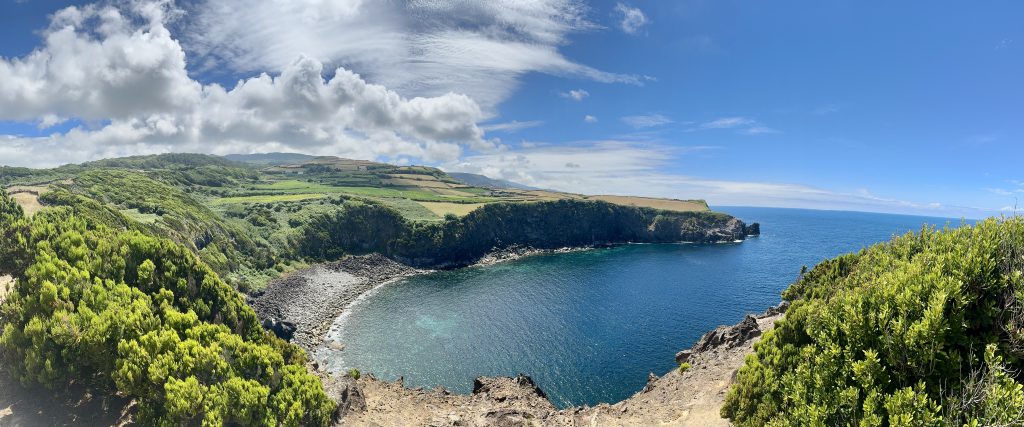
After the hike, I went to the airport to sort out my ticket issue. It turned out they only needed to see my passport to confirm the second segment of my trip—something that could have been easily handled the next morning. Since I was already in Praia, I seized the chance to pick up the last few souvenirs I needed before heading back to Santa Bárbara to pack up for my journey home.
Final Musings

The allure of the Azores beckons travelers from far and wide, offering a tapestry of reasons to embark on this enchanting journey. This archipelago, steeped in natural splendor, owes its breathtaking landscapes to the fiery genesis of its volcanic origins, setting it apart as a truly unique destination on the global map.
From the dramatic ocean cliffs to the verdant laurel forests, the Azores invite visitors to revel in the tranquility of island life and savor the beauty of the present moment. Every corner of these islands exudes a serene charm, creating ample opportunities to unwind and connect with nature.
Moreover, the hospitality of the Azorean people adds an extra layer of warmth to the experience, as they eagerly share their rich cultural heritage with all who venture to their shores. This genuine embrace of visitors resonated deeply with me, serving as a poignant reminder of the traditions and values cherished by my grandparents who once journeyed from the Azores to the United States.
Stepping foot in the Azores for the first time felt like a homecoming, a reverent acknowledgment of my familial roots intertwined with the enduring spirit of this captivating land. The sense of belonging and connection I experienced in the Azores left an indelible imprint on my soul, making this journey a truly profound and heartwarming experience.
Resources
Ready for your own Azorean adventure? Contact our excellent travel experts at 503-224-0180 or email inquiry@wittravel.com.

